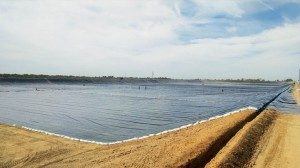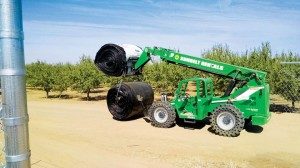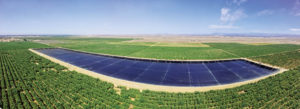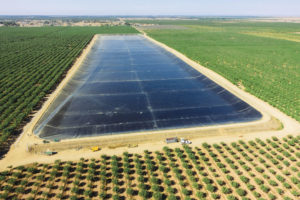Chowchilla pistachio farm
By Raphael Bennett
Introduction
Situated on 600 acres of pistachio farmland located in the northern San Joaquin Valley of California, this farm management conglomerate wanted a solution to its water accessibility issues. Due to the current water climate in California, the water loss problem with the reservoir as it previously stood had just native soil underneath so much of the water was lost back into the ground.

Knowing that the reservoir is filled only during the peak growing and harvesting seasons, it was important to select a liner that had long-term UV resistance because eight months out of the year the reservoir would likely have little to no water, leaving the geomembrane exposed to the sun.
Knowing that the reservoir is filled only during the peak growing and harvesting seasons, it was important to select a liner that had long-term UV resistance because eight months out of the year the reservoir would likely have little to no water, leaving the geomembrane exposed to the sun.
Solution
The proposal was to line the reservoir with a 30-mil, single-film, laminated (SFL) geomembrane because of the puncture resistance properties on one side and the hydrostatic resistance on the other side.
An initial visit to the site was made to obtain data, including field measurements and to address the changes that would need to be made to the plumbing system to facilitate the installation and performance of the liner. Because this was a product the farmers had not used before, all performance and sustainability concerns were hashed out in the final proposal, including the fact that the 30-mil SFL came with a 20-year exposed warranty, an important specification for this type of application.

Manufacturing
The manufacturing process includes the flat extrusion of high-density polyethylene (HDPE) tapes reoriented for strength then rolled and woven together. The 30-mil geomembrane has a laminated film coating that is reinforced on the top for increased UV protection, as well as increased hydrostatic resistance. The rolls are shipped out at up to 500 linear yards and packaged by truckload to prevent damage, then shipped directly to the fabricator.
Installation
A second trip to the reservoir was made to obtain final field measurements. Based on these measurements, custom panels were designed to fit the site with little waste. The majority of the panels were made with the same size (about 305ft x 150ft), close to one acre each.

Because it is an exposed reservoir, the common practice is to have all seams run vertical down the slopes and not horizontal across the slope; shorter panels were made to fill in the two short ends of the reservoir. These panels were approximately 80ft long.
Thirty-two of these panels were constructed, including eight of the shorter panels that completed either end. This totals 130,000 linear feet, almost 25 miles of welding done in-house, with less than 13,000 linear feet (2.46 miles) of welding done in the field. This means more than 90% of all welds were done in a controlled environment before being installed in the field.
The panels were wedge-welded and then accordion folded. They were made in 305-ft dimensions and then rewound in reroll machines. The finished panels were rolled on thick-walled, hollowed-out cardboard core with deployment straps—about 7ft long and 7ft in diameter when finished.

Timing was a huge factor in this project’s success. To meet the project deadline, manufacturing and shipping of the material in short order was crucial. Coordination and off-loading of these materials were also crucial because the technicians were on the road and would arrive on-site just after the delivery of the materials.
The crew installed, welded, and secured an average of 450,000ft 2 per day for four days—a total of 1.8 million ft2. Once the liner was completely installed, two more days were required to install the ballast tubes to prevent shifting or lifting when the reservoir is empty. The crew also finished sealing off all pipe penetration and mechanical battening areas that are part of the reservoir’s plumbing and overflow system.

With the finished project, the only water loss will now be from evaporation because there is 100% containment of the surface water. The geomembrane’s 20-year UV life span is an investment that should be beneficial for many years to come.
Raphael Bennett is marketing manager, ECP Division, Intertape Polymer Group
Photos courtesy BTL
PROJECT HIGHLIGHTS
Chowchilla, Calif.,
pistachio farm
Northern San Joaquin Valley
Partnership between
Intertape Polymer Group and BTL Liners
Fabricator and installer
BTL Liners
Geomembrane
ArmorLiner 30SFL
Manufacturer
Intertape Polymer Group
 TEXTILES.ORG
TEXTILES.ORG


